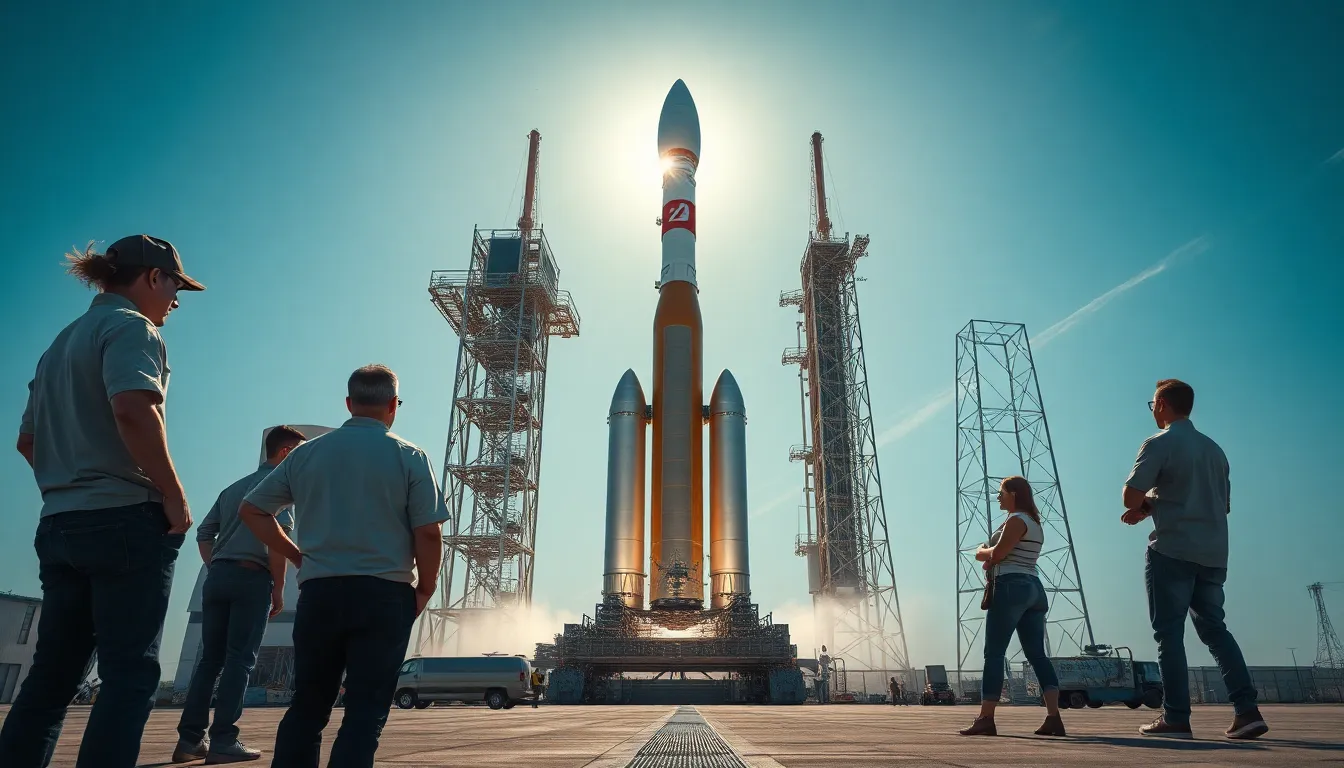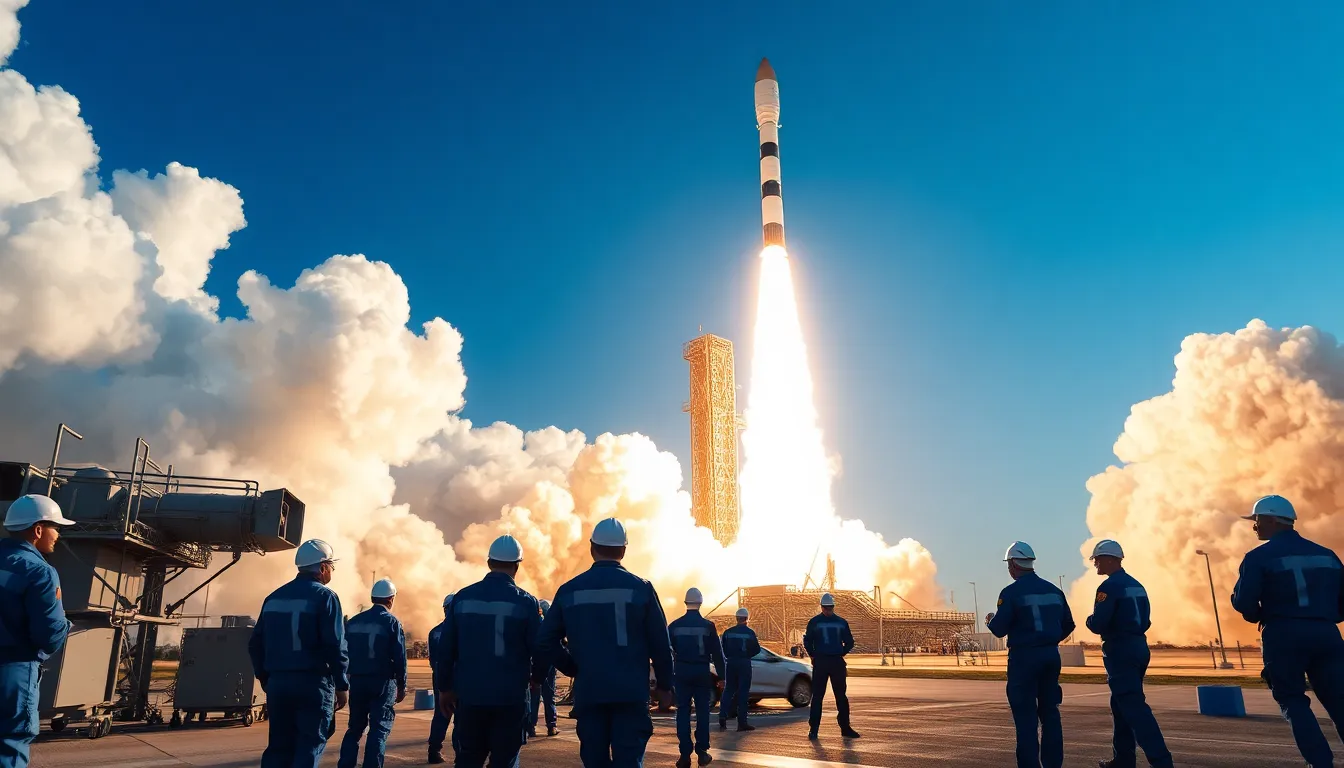In a universe brimming with possibilities, space technology stands as humanity’s ticket to the stars. From rocket boosters that defy gravity to satellites that keep us connected, the innovations in this field are nothing short of mind-blowing. Ever wondered how we manage to send a tiny rover to Mars while binge-watching our favorite shows? That’s the magic of space tech at work!
Table of Contents
ToggleOverview of Space Technology
Space technology encompasses various innovations that facilitate exploration and understanding of the universe. Powerful rocket boosters serve as the backbone for launching spacecraft, enabling missions to distant planets. Communication satellites play a crucial role in transmitting data, essential for both space missions and everyday activities like television broadcasting.
Scientific instruments mounted on spacecraft allow researchers to gather vital information about celestial bodies. Rovers equipped with advanced sensors conduct on-site analysis, offering insights into Mars’ geology and atmosphere. These technological advancements enhance our capacity to study extraterrestrial environments and gather knowledge that benefits humanity.
Satellite systems contribute significantly to Earth observation. Data collected by these satellites aids in weather forecasting, climate monitoring, and natural disaster management. Space telescopes, including the Hubble Space Telescope, provide detailed images of distant galaxies, expanding our understanding of the vast universe.
Robotic technology also plays an essential role in automated tasks. Space missions utilize drones and robotic arms to perform repairs and conduct experiments in environments where human presence is limited. Innovations like 3D printing are now being researched for building structures in space, potentially reducing transport costs.
Launch systems, such as the Space Launch System and reusable rockets, drastically lower the cost of access to space. Companies are developing technology to create a sustainable space economy, focusing on resource extraction from asteroids and lunar surfaces. Each advancement in space technology leads to new possibilities for exploration, research, and commercial applications.
Categories of Space Technology

Space technology encompasses various categories, each contributing significantly to exploration and operational capabilities.
Satellite Technology
Satellite technology plays a crucial role in global communications, Earth observation, and scientific research. Communication satellites enable broadcasting television signals and internet services, connecting remote areas worldwide. Earth observation satellites, equipped with advanced sensors, provide vital data for weather forecasting and climate analysis. Scientific satellites contribute to research by exploring phenomena like cosmic rays and solar winds, enriching our understanding of the universe. Companies continue to innovate in small satellite technology, facilitating low-cost access for both commercial and academic purposes. The integration of satellites into everyday life exemplifies the profound impact of this technology.
Launch Vehicles
Launch vehicles serve as the primary means of transporting payloads into space. Rockets rely on powerful engines generating thrust to overcome Earth’s gravity. Reusable launch systems are transforming the industry by significantly reducing costs and enabling frequent space travel. Falcon 9, developed by SpaceX, illustrates this concept by allowing multiple orbital missions with the same rocket components. Heavy-lift launch vehicles support ambitious missions, transporting larger payloads for interplanetary exploration. Continuous advancements ensure that the launch capabilities evolve rapidly, opening pathways for future endeavors.
Spacecraft Systems
Spacecraft systems integrate various technologies essential for space missions. These systems include propulsion, navigation, and communication functionalities. Advanced propulsion systems enable efficient travel to distant celestial bodies, while precise navigation ensures accurate trajectory adjustments. Communication systems facilitate data transfer between spacecraft and mission control, guaranteeing real-time updates. Automated systems and robotics enhance spacecraft capabilities, allowing for remote operation and repairs. Each component within a spacecraft plays a vital role, ensuring successful missions while expanding human presence throughout the solar system.
Emerging Trends in Space Technology
Innovations in space technology continue shaping exploration opportunities. Notable trends include the rise of CubeSats and reusable rocket technology.
CubeSats and Small Satellites
CubeSats represent a significant leap in satellite technology. These miniature satellites, often measuring just 10 cm on each side, support a variety of missions. Applications range from Earth observation to scientific research and technological demonstration. Organizations and academic institutions utilize CubeSats due to their cost-effectiveness and flexibility. Additionally, advancements in miniaturization enable more complex instruments onboard. This simplifies launching multiple satellites at once, enhancing data collection and collaboration among countries and institutions.
Reusable Rocket Technology
Reusable rocket technology is revolutionizing space travel. Prominent companies like SpaceX have pioneered systems that allow rockets to be launched, landed, and reused multiple times. Cost reductions are substantial, as reusing rockets mitigates expenses associated with manufacturing new units for each mission. Reusable designs improve efficiency in launch schedules, ensuring more frequent access to space. Furthermore, innovations like vertical landing techniques enhance recovery operations. This trend signifies a shift toward sustainability in the space industry and opens avenues for more ambitious missions beyond Earth.
Applications of Space Technology
Space technology has diverse applications that significantly impact everyday life and advance human understanding of the universe.
Earth Observation and Monitoring
Earth observation systems leverage satellites to collect valuable data about the planet. These systems play a critical role in weather forecasting, climate change tracking, and natural disaster management. Satellites equipped with advanced sensors monitor environmental parameters, providing real-time information on phenomena like hurricanes and wildfires. Data gathered from these satellites aids researchers in studying climate patterns and predicting extreme weather events. The integration of satellite imagery into various sectors enhances agricultural practices, urban planning, and biodiversity conservation. Overall, Earth observation technologies contribute to informed decision-making and improved resource management.
Communication and Navigation
Communication satellites enable global connectivity, allowing users to access information anytime and anywhere. These satellites support television broadcasting, internet services, and mobile communications, forming an essential backbone for modern communication networks. Navigation systems, such as GPS, rely on a constellation of satellites that provide location data with high accuracy. Transportation sectors, including aviation and maritime, depend on these systems for safe and efficient operations. Innovations in satellite communication have also improved global responses to emergencies, facilitating coordination among first responders. The advancements in this field continue to enhance communication capabilities across the globe.
Future of Space Technology
Advancements will redefine space technology’s landscape significantly. Innovative propulsion systems aim to enhance mission efficiency, enabling faster travel within the solar system. Solar sails, harnessing sunlight, present a promising avenue for propulsion, propelling missions toward distant planets with minimal fuel requirements.
Another promising development involves human habitats on Mars and the Moon, focusing on sustainability for long-term exploration. These habitats will incorporate advanced life support systems, recycling resources to support astronauts during extended missions. Innovations in 3D printing technology further support habitat creation, using local materials for construction, cutting down on supply needs from Earth.
Artificial intelligence plays a pivotal role in the future of space exploration. AI-driven systems will assist in data analysis from space missions, providing real-time decisions during critical moments. Data from robotic missions will enhance scientific research, enabling deeper insights into planetary geology and atmospheres.
In the realm of asteroid mining, companies are exploring technology for extracting valuable resources. This creates possibilities for in-space resource utilization, which could lead to reduced costs for space missions by utilizing materials from celestial bodies. Efforts in developing electric propulsion systems aim to facilitate these resource extraction efforts.
Collaborative missions between nations and private entities are on the rise. International partnerships will lead to shared resources, technology, and expertise, fostering advancements in spacecraft design, satellite technology, and research initiatives. As space becomes increasingly accessible, educational institutions are also participating in small satellite missions, promoting workforce development and innovation.
Emerging space tourism offers potential for commercial growth, providing opportunities for civilians to experience space travel. Companies are developing suborbital and orbital flights, making space exploration more inclusive. Each of these advancements brings humanity closer to realizing its ambitions for deep space exploration and commercial opportunities.
The advancements in space technology are not just reshaping exploration but also enhancing everyday life on Earth. With each innovation in satellite systems and launch vehicles, humanity’s reach into the cosmos expands. The development of reusable rockets and CubeSats is making space more accessible and sustainable.
As artificial intelligence and new propulsion systems emerge, they promise to revolutionize how missions are conducted. The potential for asteroid mining and space tourism opens doors to commercial opportunities previously thought unattainable.
These advancements signify a bright future for space exploration and technology, bringing humanity closer to its dreams of understanding the universe and utilizing its resources.




